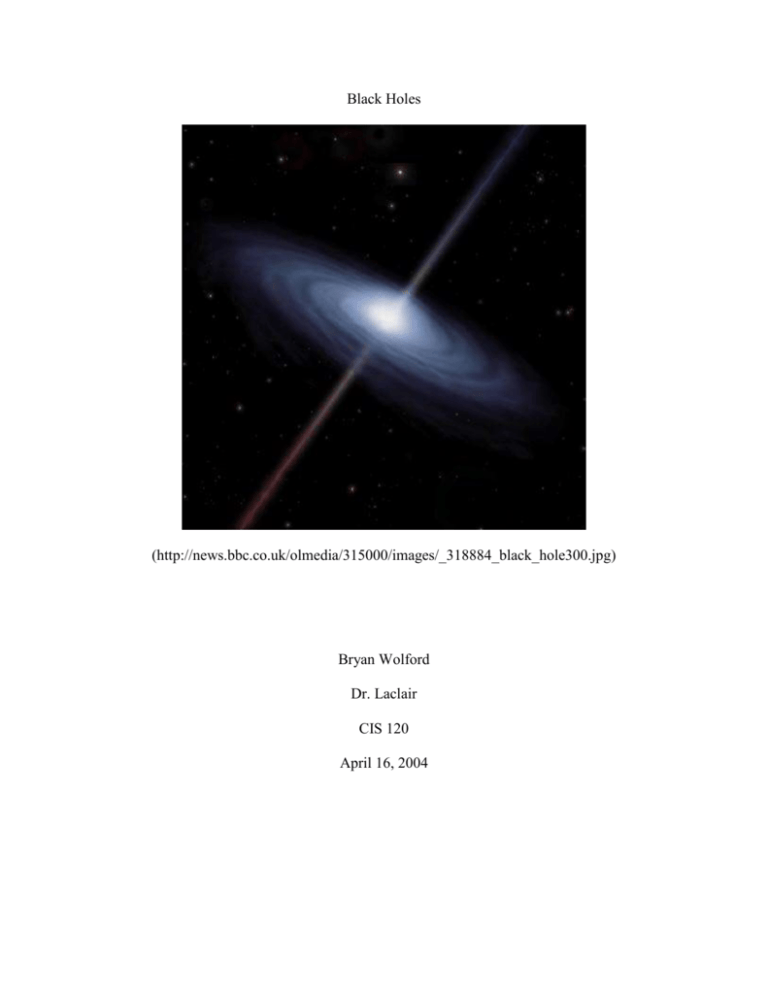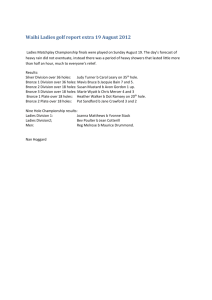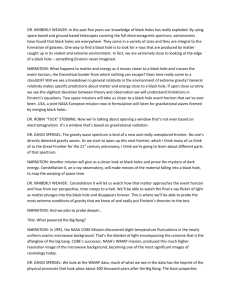Internet Research Paper
advertisement

Black Holes (http://news.bbc.co.uk/olmedia/315000/images/_318884_black_hole300.jpg) Bryan Wolford Dr. Laclair CIS 120 April 16, 2004 Wolford 1 Bryan Wolford Dr. Laclair CIS 120 April 16, 2004 Black Holes Although Physicists have been arguing in the past about black holes they now agree on many things through the use of new technology. This is quite important because if not the most important aspect of the black hole is its exact function as well as definition. Now physicist can agree on such things as the creation of black holes as well as the death process of black holes. The next thing which has happened fairly recently is the sighting of a black hole near the center of the Milky Way galaxy, which has led into the theory that there could be black holes at nearly the center of every galaxy. The last thing which is worth talking about along with black holes is the theory of a dark matter which is supposed to be made up of an element which is not know to us and is supposed to contain the majority of the mass in the universe. These are the most important aspects when discussing the theories of the universe. The best definition on this subject comes from an astronomy text book and it states: “An object whose gravity is so strong that the escape velocity from it exceeds the speed of light” (Comins G-1). This mean that the vacuum and gravitational pull which the black hole is creating is strong enough to contain the speed of light which is a constant speed equaling 1.86*10^5km/s (68). This is the basic definition of what advances have been made and what the exact definition is of a black hole. Wolford 2 The inventions which have helped to bring the physicist closer to the same understanding of what a black hole is and how it functions is basically provided by technology. The technology which contributes would be the new computer simulation programs to help show the physicist’s idea to the rest of the physics community. Also, newer telescopes, such as the Hubble, gives us a better look at the universe which was almost unseen by the older versions of telescopes. Then the person who helped to come up with new basic ideas for black holes and there functions was brought up by the physicist, Stephen Hawking. The creation as well as death has become more evident now than in the past because of the new technologies as well as genius physicists. I believe that Steven Hawking gives the best example of the creation of a black hole: Stars or galaxies eventually collapse upon themselves some evidently causing black holes (Hawking, The Universe in a Nutshell 41). This means that the star under it own weight and gravity slowly begins to contract upon itself starting to increase its gravitational pull until light itself can not escape due to such gravitational force, and it also shows that time would eventually reach an end inside on of these massive black holes (41). The theory of black holes can not easily be introduced into society because the theories which are usually used to help explain the theory of a gravitational force are usually shown with just a few particles of the substance colliding with one another, not million or even billions which is usually associated with the black hole. However, one theory has been created in order to help demonstrate such activities which is known as the M-theory (57). The formula for such a black hole is now known as the black hole entropy formula; where A=to the area Wolford 3 of the event horizon of a black hole; h=Planck’s constant; k=Boltzmann’s constant; G=Newton’s gravitational constant; c=speed of light; and S=Entropy: Helps to create the equation: S=Akc^3 4hG (63). The loss of our ability to see into the past by looking at future galaxies is going to eventually become harder: “How the loss of information in black holes may reduce our ability to predict the future” (101). This shows how black holes are formulated as well as the formula for explaining such phenomena. The next area, which is of the up-most importance, is the ability for physicist to tell where a black hole might be or in what vicinity it could possibly reside. Black holes are really a transparent color because the escaping rays of light coming out of a black hole or near a black hole makes the object appear to be black because the space it occupies is a lightless matter that appears to be black (Hawking, A Brief History of Time 103-104). The last subject that the theory of a black hole covers is that of a reproduction of itself. “When big black holes give birth they eat their offspring, according to a simulation of these cataclysmic events. These acts of cosmic cannibalism could soon be picked up by space-based detectors of gravitational waves” (Chowen, Marcus. “Baby black holes have a tough life ahead of them.”). This is why black holes have the appearance of being black, and the fact that black holes can not reproduce themselves. A new startling discovery has created quite a controversy in the physics community when it was discovered that there is a giant black hole lurking in the center of Wolford 4 the Milky Way Galaxy (Cowen, Ron. “Mystery in the middle: a stellar riddle turns up at the Milky Way’s core.”). The questions raised by this discovery cover quite a wide variety of subject such as the suggestion that there are black holes at nearly the center of every galaxy (Cowen, Ron. “Photon drag: new spin on making a black hole.”). Then if anything are the long term effects of these black holes (Cowen, Ron. “Repaired Hubble finds giant black hole.”). Would these black holes keep us from looking into the past as we look through space and subsequently time (Hawking, The Universe in a Nutshell 101). The first major event into leading to the belief that there could possibly be a black hole is when the Hubble telescope was repaired: “After years of hunting for black holes, astronomers say they have found the first convincing proof that one exists at the center of a galaxy” (Cowen, Ron. “Repaired Hubble finds giant black hole.”). The theory behind this belief is that: “And stars and gas orbiting the core would whip around so rapidly that the tug from visible matter alone couldn’t account for their motion” (Cowen, Ron. “Repaired Hubble finds giant black hole.”). Another quote which seems to help back up this theory is: “Some galaxies have a heart of fire, a center so luminous that it outshines the rest of the starlit body most astronomers believe that a black hole fuels the fireworks at the core of such galaxies, known as active galactic nuclei” (Cowen, Ron. “Photon drag: new spin on making a black hole.”). Later evidence has shown that a black hole even resides at the center of the Milky Way galaxy: “The great speed with which these centrally located stars whirl around provides the best evidence to date for the existence of an extremely dense and massive object—a supermassive black hole—right in the bull’s- Wolford 5 eye of the galaxy” (Cowen, Ron. “Mystery in the middle: a stellar riddle turns up at the Milky Way’s core.”). What happens to the stars which are so near the black hole: “On the other hand, models in which massive stars are born at a safe distance from a black hole— about 100 light-years—and then migrate toward its galaxy’s core have their own problems. Since massive stars last only a few million years, they should die out long before they complete the journey inward” (Cowen, Ron. “Mystery in the middle: a stellar riddle turns up at the Milky Way’s core.”). There are many other mysterious things which make up the universe. We have discussed black holes, but there are worm holes and dark matter which are completely theoretical. No-one really knows how a worm hole works, but hopefully through the advancement of technology we will understand and maybe even learn to harness the power of the wormhole. The other thing which puzzles physicist as well as other scientists is the possible existence of dark matter. “A rapidly moving, hot dark matter could be made up of particles called neutrinos, but measurements of neutrino mass indicate that they are too lightweight to account for much of the dark matter” (Pasachoff). “Since normal matter and dark matter account for only 27 percent of the material necessary for the universe to be at the critical density, the remaining 73 percent of the universe must be composed of a still more mysterious substance that astronomers have named “dark matter”” (Pasachoff). This shows that there are still substances that have not even been identified but given a class name. (http://www.esrin.esa.it/export/images/08_BLACKHOLE_M.jpg). Wolford 6 Works Cited Chowen, Marcus. “Baby black holes have a tough life ahead of them.” New Scientists v179i2405 July 26, 2003: p.15. Infotrac. Expanded Academic ASAP. Cochise College Libraries, Sierra Vista, Arizona. 3/22/04. http://web6.infotrac.galegroup.com/itw/infomark/641/780/47123840w6/purl=rc1_ EAIM_0_A106233200&dyn=20!xrn_1_0_A106233200?sw_aep=cochisecollib Comins, Neil F. and William J. Kaufmann III. Discovering The Universe. 6th edition. New York: W.H. Freeman And Company, 2003. Cowen, Ron. “Mystery in the middle: a stellar riddle turns up at the Milky Way’s core.” Science News v163i25 June 21, 2003: p.394(3). Infotrac. Expanded Academic ASAP. Cochise College Libraries, Sierra Vista, Arizona. 3/22/04. http://web6.infotrac.galegroup.com/itw/infomark/641/780/47123840w6/purl=rc1_ EAIM_0_A106028264&dyn=25!xrn_2_0_A106028264?sw_aep=cochisecollib Cowen, Ron. “Photon drag: new spin on making a black hole.” Science News v143n6 February 6, 1993: p.86. Infotrac. Expanded Academic ASAP. Cochise College Libraries, Sierra Vista, Arizona. 3/22/04. http://web6.infotrac.galegroup.com/itw/infomark/641/780/47123840w6/purl=rc1_ EAIM_0_A13434453&dyn=8!xrn_3_0_A13434453?sw_aep=cochisecollib Cowen, Ron. “Repaired Hubble finds giant black hole.” Science News v145n23 June 4, 1994: p.356(2). Infotrac. Expanded Academic ASAP. Cochise College Libraries, Sierra Vista, Arizona. 3/22/04. Wolford 7 http://web6.infotrac.galegroup.com/itw/infomark/641/780/47123840w6/purl=rc1 EAIM_0_A16007808&dyn=20!xrn_13_0_A16007808?sw_aep=cochisecollib Hawking, Stephen. A Brief History of Time. New York: Bantam Books, 1996. Hawking, Stephen. The Universe In A Nutshell. New York: Bantam Books, 2001. Pasachoff, Jay M., A.B., A.M., Ph.D. “Cosmology.” Microsoft Online Encyclopedia 2004. 1997-2004 microsoft Corporation. 4/13/04. http://encarta.msn.com/text_761564398__30/Cosmology.html http://news.bbc.co.uk/olmedia/315000/images/_318884_black_hole300.jpg http://www.esrin.esa.it/export/images/08_BLACKHOLE_M.jpg







